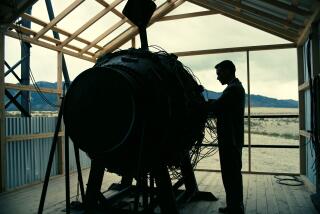Hiroshima Might Have Been Here : Japan was working on an atomic bomb up until the day of surrender; we don’t have to apologize for using ours first.
- Share via
Hiroshima and Nagasaki, we are told, balanced the moral scales for the Japanese attack on Pearl Harbor. That argument is simplistic and wrong. Even if one sets aside the rape of Nanking, the concentration camps at Singapore and the Bataan death march, the scales are out of balance. American use of nuclear weapons to end the war in the Pacific would balance Pearl Harbor only if Japanese hands were not also contaminated by atomic arms.
Right up until the day of surrender, Japan had an active nuclear-weapons development program, one that is amply documented but conveniently overlooked, allowing the Japanese to paint themselves as the innocent first atomic victims.
Japanese research was centered at the Physical and Chemical Research Institute, the Riken. European-trained physicist Yoshio Nishina had built a small cyclotron there and was at work on a much larger machine patterned after the cyclotron at Berkeley, where Ernest Lawrence first separated bomb-grade uranium.
Nishina began experiments on the Japanese nuclear project in December, 1940. The Imperial Army ordered him to begin work on atomic weapons in April, 1941--almost nine months before Pearl Harbor. The Manhattan Project was formally started on Dec. 6, 1941.
By July, 1943, Nishina could tell his superiors that uranium enriched to 50% uranium-235 would suffice for a bomb, and that somewhere between 10 and 50 kilograms would be sufficient--a range that brackets the correct figure. By then, Nishina had produced 170 grams of the gas uranium hexafluoride and was studying techniques to make the enriched product.
Japan was then running about a year behind the Manhattan Project. Scarcity of resources and losses to the American aerial bombardment pushed the Riken project even further behind. Japan would lose the race to produce nuclear weapons, but would continue trying until the last moment of the conflict.
Suppose that Japan had completed its first nuclear bomb before the war ended, even after the bombing of Hiroshima. There can be no doubt that the imperial armed forces would have employed it in battle. Whether the bomb was delivered by suicide submarine or kamikaze aircraft, its target would have been Americans, either those in invasion fleets off Japan’s home islands or in some West Coast city.
The attempt to build a nuclear weapon with the intention of using it has exactly the same moral weight as the use of the weapon itself. If Japan considers American hands to have been soiled by the atomic bomb, then Japanese hands are equally dirty, even if most Japanese are unaware.
The bombing of Hiroshima and Nagasaki also can be justified on comparative grounds, for it led to the immediate end of the war and, ultimately, to the birth of Japanese democracy. A Japanese bomb would have perpetuated the empire. America has nothing to apologize for.
More to Read
Sign up for Essential California
The most important California stories and recommendations in your inbox every morning.
You may occasionally receive promotional content from the Los Angeles Times.










